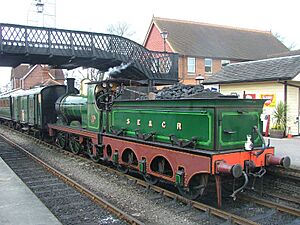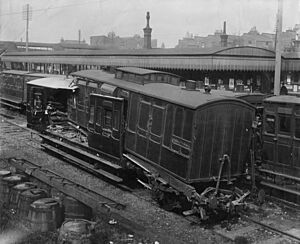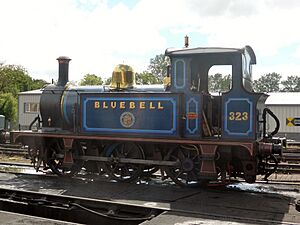South Eastern and Chatham Railway facts for kids
 |
|

1920 map of the railway
|
|
| Technical | |
|---|---|
| Track gauge | 4 ft 8 1⁄2 in (1,435 mm) |
| Length | 637 miles 61 chains (1,026.4 km) (1919) |
| Track length | 1,302 miles 24 chains (2,095.8 km) (1919) |
The South Eastern and Chatham Railway (SE&CR) was a special railway company in England. It was formed in 1899 by joining two railway companies that used to be big rivals: the South Eastern Railway (SER) and the London, Chatham and Dover Railway (LC&DR).
These two companies operated trains between London and the south-east of England, especially in Kent. They also ran services to important ports where people could catch ferries to France and Belgium. From 1899 until 1923, the SE&CR was the main railway in Kent.
Before they joined, the SER and LC&DR were known for their fierce competition. They often built similar routes to the same towns, which meant some places in Kent had two railway stations and services to different parts of London! This competition was very expensive for both companies.
In 1923, the SE&CR became part of a much larger company called the Southern Railway. This happened because of a big change in British railways called the 1923 Grouping.
Contents
How the SE&CR Was Formed
By the late 1800s, the South Eastern Railway (SER) and the London, Chatham and Dover Railway (LC&DR) had been competing for about 40 years. Their rivalry was so intense that it almost made both companies go bankrupt. They were also known for trains that were often late and old, worn-out carriages. It became clear they had to work together or face serious problems.
So, on January 1, 1899, the SE&CR was created. It wasn't a full merger at first. Instead, the two companies formed a "management committee" made up of directors from both sides. This committee took over running all the trains and operations. The companies still existed separately on paper, but they worked as one. This helped them avoid the high costs and risks of a complete merger. They agreed to share the money they earned, with the SER getting 59% and the LC&DR getting 41%.
| South Eastern and London, Chatham and Dover Railways Act 1899 | |
|---|---|
| Act of Parliament | |

|
|
| Long title | An Act to provide for the working union of the South Eastern and London Chatham and Dover Railway Companies and for other purposes. |
| Citation | 62 & 63 Vict. c. clxviii |
| Dates | |
| Royal assent | 1 August 1899 |
A special law, called the South Eastern and London, Chatham and Dover Railways Act 1899, was passed on August 5, 1899. This law officially allowed the two companies to work together.
Connecting the Railway Lines

Once the SE&CR was formed, it started connecting the two railway networks. This allowed them to introduce new train services and make things more efficient.
One important project was building a new connection between the SER and LC&DR main lines. This happened between 1902 and 1904 near Bickley and St Mary Cray, east of Bromley. They also connected the LC&DR's line to Ashford with the SER station there. Before World War I, the SER branch line from Strood to Chatham was closed because the LC&DR already had a main line to Chatham. Later, the overlapping lines on the Isle of Thanet (Margate-Broadstairs-Ramsgate) were also made simpler.
New Railway Lines Built
After the SE&CR was formed, but before it became part of the Southern Railway in 1923, three smaller railway lines were built:
- The Tattenham Corner branch: This line opened in 1901 and went from Kingswood to Tattenham Corner.
- The Sheppey Light Railway: This was a branch off the Sheerness branch and opened in 1901. It closed in 1950.
- The Bexhill branch: This line opened in 1902 and went from Crowhurst (on the Hastings Line) to Bexhill West. This line is now closed.
Train Accidents and Incidents
Even with new management, accidents sometimes happened on the railway. Here are a few notable incidents:
- On March 21, 1898, a passenger train crashed into the back of another passenger train at St Johns, London. This happened because a signalman made a mistake. Three people died, and twenty were hurt.
- In March 1904, a passenger train went off the tracks at Gomshall, Surrey.
- On December 6, 1905, part of the roof at Charing Cross station collapsed. Six people were killed, and eight were injured.
- On March 5, 1909, an express passenger train went past signals and crashed into a mail train at Tonbridge Junction, Kent. Two people died, and eleven were injured.
- On March 11, 1913, a passenger train failed to stop at Ramsgate Town station, Kent. It crashed into a van, pushing it through the buffers. The accident happened because the brakes were not properly connected between the engine and the train. Ten people were injured.
- On May 5, 1919, a freight train went past signals and crashed into another freight train that was being moved at Paddock Wood, Kent. One person was killed.
SE&CR Locomotives
The LC&DR's workshops at Longhedge, Battersea closed in 1911. After that, all the work on locomotives was done at Ashford. Harry Wainwright was the Chief Mechanical Engineer until 1913, when Richard Maunsell took over.
You can find a full list of their locomotives here: List of locomotives.
Plans for Electric Trains
In the early 1900s, other railway companies like the L&SWR and the LB&SCR started using electric trains. The SE&CR also made plans to electrify its lines.
Their idea was to use a special "four-rail" system. This system would have used very high voltage electricity. However, when the "Grouping" happened in 1923, the Southern Railway took over. The Southern Railway decided to use the L&SWR's standard system of 660 volts DC with a "third rail" instead. This meant the SE&CR's original plans for electrification were not carried out.
Important People at SE&CR
Some key people helped run the SE&CR:
- Harry Wainwright: He was the Chief Mechanical Engineer from 1899 to 1913. He was in charge of designing and maintaining the trains.
- Richard Maunsell: He took over from Harry Wainwright as Chief Mechanical Engineer from 1913 to 1923.
- Alfred Weeks Szlumper: He worked as an Engineering Assistant from 1880 to 1882, even before the SE&CR was officially formed.
Ships Operated by SE&CR
The SE&CR also operated ships for cross-channel services, taking passengers and goods across the English Channel.
Ships from the South Eastern Railway (SER)
| Ship | Launched | Tonnage (GRT) | Notes |
|---|---|---|---|
| Albert Victor | 1880 | 814 | Taken apart for scrap in 1899. |
| Boulogne | 1878 | 407 | Sold in 1903. |
| Duchess of York | 1895 | 996 | Taken apart for scrap in 1904. |
| Folkestone | 1878 | 398 | Taken apart for scrap in 1903. |
| Louise Dagmar | 1880 | 818 | Taken apart for scrap in 1899. |
| Mary Beatrice | 1882 | 803 | Taken apart for scrap in 1900. |
| Princess of Wales | 1898 | 1,009 | Sold in 1910 to Argentina, renamed Río Uruguay. |
Ships from the London, Chatham and Dover Railway (LC&DR)
| Ship | Launched | Tonnage (GRT) | Notes |
|---|---|---|---|
| Breeze | 1863 | 385 | Taken apart for scrap in 1899. |
| Calais | 1896 | 979 | Sold in 1911, renamed Au Revoir. |
| Calais-Douvres | 1889 | 1,212 | Sold in 1900. |
| Dover | 1896 | 979 | Taken apart for scrap in 1911. |
| Empress | 1887 | 1,213 | Taken apart for scrap in 1906. |
| Foam | 1862 | 495 | Taken apart for scrap in 1901. |
| France | 1864 | 365 | Taken apart for scrap in 1899. |
| Invicta | 1882 | 1,282 | Taken apart for scrap in 1899. |
| Lord Warden | 1896 | 979 | Taken apart for scrap in 1911. |
| Petrel | 1862 | 503 | Taken apart for scrap in 1899. |
| Prince | 1864 | 338 | Taken apart for scrap in 1899. |
| Samphire | 1861 | 336 | Taken apart for scrap in 1899. |
| Victoria | 1886 | 1,042 | Taken apart for scrap in 1904. |
| Wave | 1863 | 385 | Taken apart for scrap in 1899. |
Ships Built for the SE&CR
| Ship | Launched | Tonnage (GRT) | Notes |
|---|---|---|---|
| Biarritz | 1914 | 2,495 | Taken apart for scrap in 1949 at Dover. |
| Canterbury | 1900 | 561 | Sold in 1926, renamed Arpha. Later used by the Royal Navy. Taken apart for scrap after 1955. |
| Empress | 1907 | 1,689 | Used by the Royal Navy in 1914, sold to France in 1923. Taken apart for scrap in 1933. |
| Engadine | 1911 | 1,676 | Used by the Royal Navy in 1914, returned in 1920. Sold in 1933, renamed Corregidor. Sank after hitting a mine on December 17, 1941. |
| Invicta | 1905 | 1,680 | Sold in 1923 to France. Taken apart for scrap in 1932. |
| Mabel Grace | 1899 | 1,289 | Taken apart for scrap in 1909. |
| Maid of Orleans | 1918 | 2,384 | Sunk by a torpedo on June 28, 1944. |
| Onward | 1905 | 1,671 | Caught fire in 1918 and sank. Rescued in 1920, rebuilt as Mona's Isle. Taken apart for scrap in November 1948. |
| Riviera | 1911 | 1,674 | Used by the Royal Navy in 1914, returned in 1920. Sold in 1932, renamed Laird's Isle. Taken apart for scrap in October 1957. |
| The Queen | 1903 | 1,676 | Captured and sunk by a German destroyer on October 26, 1916. |
| Victoria | 1907 | 1,689 | Sold in 1928. Taken apart for scrap in January 1957. |
Other Ships Used by SE&CR
| Ship | Launched | Tonnage (displacement) |
Notes |
|---|---|---|---|
| Gannet | 1878 | 1,130 | Used as a floating home for sailors at Port Victoria from 1900 to 1903. |




